

| VM-T Atlant | |
|---|---|

| |
| VM-T with the 3GT payload container at the Zhukovsky Air Show in 2005 | |
| Role | Outsize cargo transport
Type of aircraft
|
| Manufacturer | Myasishchev |
| Designer | Vladimir Mikhailovich Myasishchev |
| First flight | 29 April 1981 |
| Introduction | January 1982 |
| Retired | 1989 |
| Status | Retired |
| Primary users | Soviet Air Force Russian Federal Space Agency (Soviet space program) |
| Number built | 2 |
| Developed from | Myasishchev M-4 |
The Myasishchev VM-T Atlant (Russian: Мясищев ВМ-Т «Атлант» ("Atlas"), with the "VM-T" ("BM-T") standing for Vladimir Myasishchev – Transport) was a variant of Myasishchev's M-4 Molot bomber (the "3M"), re-purposed as a strategic-airlift airplane. The VM-T was modified to carry rocket boosters and the Soviet space shuttles of the Buran program. It is also known as the 3M-T.
The design was conceived in 1978 when Myasishchev was asked to solve the problem of transporting rockets and other large space vehicles to the Baikonur Cosmodrome. Engineers used an old 3M (a modified M-4 bomber) and replaced the empennage with dihedralled horizontal stabilizers with large, rectangular end-plate tailfins to accommodate payloads measuring as large as twice the diameter of the aircraft's fuselage. A large, aerodynamically optimized cargo container, placed on top of the aircraft, would contain the freight. In addition, a new control system was added to the plane to compensate for the added weight.
The Atlant first flew in 1981 and made its first flight with cargo in January 1982.[1] Its main task was to ferry Energia rocket boosters from their development plant to the Baikonur Cosmodrome. On several occasions, the then-incomplete Soviet space shuttle Buran was piggybacked to the Cosmodrome as well.[1]
Two Atlants were built. They were replaced in 1989 by Antonov's An-225 Mriya. One Atlant (RF-01502) is kept at the Zhukovsky International AirportinRussia owned by TsAGI and Gromov Flight Research Institute, the other one (RA-01402) at Dyagilevo (air base)inRyazan. 0GT was the Buran spaceplane without tailplane and equipment, 1GT was the hydrogen tank of the Energia rocket, 2GT was the engine frame and front aerodynamic cover of Energia and 3GT was the oxygen tank of Energia. All configurations were equipped with aerodynamic cover to decrease the drag.[2]
Data from Jane's aircraft recognition guide 1996,[3] VM-T Atlant's mains characteristics,[4]
General characteristics
Performance
Related development
Aircraft of comparable role, configuration, and era
|
Myasishchev aircraft
| |
|---|---|
| Civil |
|
| Military |
|
| Space |
|
|
Aircraft designed for the carriage of outsize cargo
| |
|---|---|
| In service |
|
| Retired |
|
| Unbuilt |
|